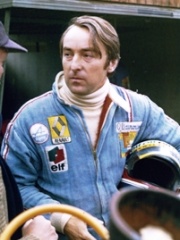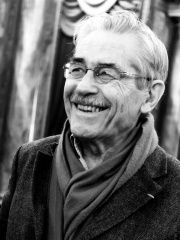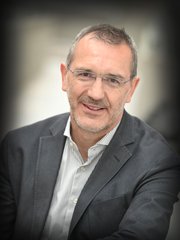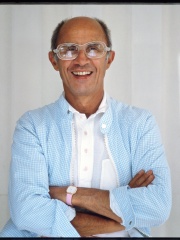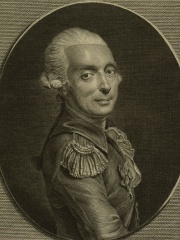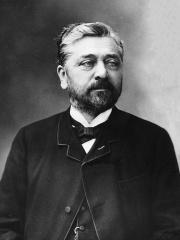
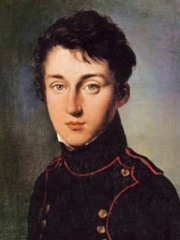
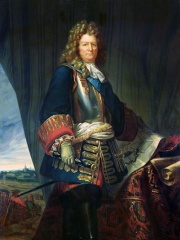
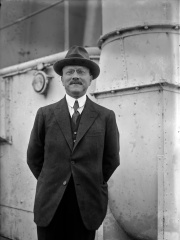
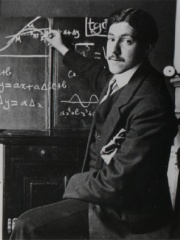
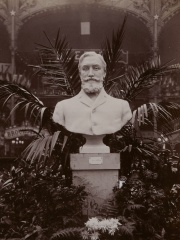
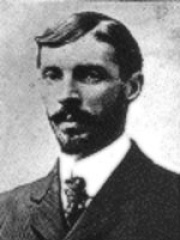
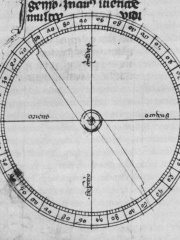
The Most Famous
ENGINEERS from France
Top 10
The following people are considered by Pantheon to be the top 10 most legendary French Engineers of all time. This list of famous French Engineers is sorted by HPI (Historical Popularity Index), a metric that aggregates information on a biography's online popularity. Visit the rankings page to view the entire list of French Engineers.

1. Gustave Eiffel (1832 - 1923)
With an HPI of 83.25, Gustave Eiffel is the most famous French Engineer. His biography has been translated into 95 different languages on wikipedia.
Alexandre Gustave Eiffel ( EYE-fəl, French: [alɛksɑ̃dʁ ɡystav ɛfɛl]; né Bonickhausen dit Eiffel; 15 December 1832 – 27 December 1923) was a French civil engineer. A graduate of École Centrale des Arts et Manufactures, he made his name with various bridges for the French railway network, most famously the Garabit Viaduct. He is best known for the Eiffel Tower, designed by his company and built for the 1889 Universal Exposition in Paris, and his contribution to building the Statue of Liberty in New York. After his retirement from engineering, Eiffel focused on research into meteorology and aerodynamics, making significant contributions in both fields.

2. Nicolas Léonard Sadi Carnot (1796 - 1832)
With an HPI of 77.68, Nicolas Léonard Sadi Carnot is the 2nd most famous French Engineer. His biography has been translated into 70 different languages.
Nicolas Léonard Sadi Carnot (French: [nikɔla leɔnaʁ sadi kaʁno]; 1 June 1796 – 24 August 1832) was a French military engineer and physicist. A graduate of the École polytechnique, Carnot served as an officer in the Engineering Arm (le génie) of the French Army. He also pursued scientific studies and in June 1824 published an essay titled Reflections on the Motive Power of Fire. In that book, which would be his only publication, Carnot developed the first successful theory of the maximum efficiency of heat engines. Carnot's scientific work attracted little attention during his lifetime, but in 1834 it became the object of a detailed commentary and explanation by another French engineer, Émile Clapeyron. Clapeyron's commentary in turn attracted the attention of William Thomson (later Lord Kelvin) and Rudolf Clausius. Thomson used Carnot's analysis to develop an absolute thermodynamic temperature scale, while Clausius used it to define the concept of entropy, thus formalizing the second law of thermodynamics. Sadi Carnot was the son of Lazare Carnot, an eminent mathematician, engineer, and commander of the French Revolutionary Army and later of the Napoleonic army. Some of the difficulties that Sadi faced in his own career might have been connected to the persecution of his family by the restored Bourbon monarchy after the fall of Napoleon in 1815. Sadi Carnot died in relative obscurity at the age of 36, but today he is often characterized as the "father of thermodynamics".

3. Sébastien Le Prestre de Vauban (1633 - 1707)
With an HPI of 73.84, Sébastien Le Prestre de Vauban is the 3rd most famous French Engineer. His biography has been translated into 52 different languages.
Sébastien Le Prestre, Marquis of Vauban (May 1633 – 30 March 1707) was a French Royal Army officer who served under Louis XIV. One of the most important military engineers in European history, his defensive principles remained in use for nearly 100 years after his death, while aspects of his offensive tactics were employed into the 20th century. Viewing civilian infrastructure as closely connected to military effectiveness, Vauban upgraded many of France's major ports, as well as new projects like the Canal de la Bruche, which is still in use today. He founded the Corps royal des ingénieurs militaires, whose curriculum was based on his own principles of design, strategy and training. His economic tract, La Dîme royale, used statistics in support of his arguments, making it a precursor of modern economics. Later destroyed by royal decree, it contained radical proposals for a more even distribution of the tax burden. His application of rational and scientific methods to solving engineering and social issues anticipated an approach common in the Age of Enlightenment. Perhaps the most enduring aspect of Vauban's legacy was his view of France as a geographical entity. His advocacy of giving up territory for a more coherent and defensible border was unusual for the period; the boundaries of the French state he proposed in the north and east have changed very little since.

4. André Citroën (1878 - 1935)
With an HPI of 73.43, André Citroën is the 4th most famous French Engineer. His biography has been translated into 49 different languages.
André-Gustave Citroën (French: [ɑ̃dʁe ɡystav sitʁɔɛn]; 5 February 1878 – 3 July 1935) was a French industrialist and the founder of French automaker Citroën. He is also remembered for his application of double helical gears.

5. Villard de Honnecourt (1200 - 1250)
With an HPI of 68.49, Villard de Honnecourt is the 5th most famous French Engineer. His biography has been translated into 25 different languages.
Villard de Honnecourt (Wilars dehonecort, Vilars de Honecourt) was a 13th-century artist from Picardy in northern France. He is known to history only through a surviving portfolio or "sketchbook" containing about 250 drawings and designs of a wide variety of subjects.

6. Marcel Dassault (1892 - 1986)
With an HPI of 65.85, Marcel Dassault is the 6th most famous French Engineer. His biography has been translated into 33 different languages.
Marcel Dassault (French pronunciation: [maʁsɛl daso]; born Marcel Ferdinand Bloch; 23 January 1892 – 17 April 1986) was a French engineer and industrialist who spent his career in aircraft manufacturing. He was also involved in politics, serving intermittently over more than three decades in both houses of the French Parliament from 1951 until his death in 1986.

7. Marcel Renault (1872 - 1903)
With an HPI of 65.35, Marcel Renault is the 7th most famous French Engineer. His biography has been translated into 25 different languages.
Marcel Renault (14 May 1872 – 26 May 1903) was a French racing driver and industrialist, co-inheritor of an important textile business and co-founder of the carmaker Renault with his brothers Louis and Fernand Renault. He died at 31 years old due to injuries from the Paris–Madrid race of 1903.

8. Henri Farman (1874 - 1958)
With an HPI of 65.26, Henri Farman is the 8th most famous French Engineer. His biography has been translated into 29 different languages.
Henri Farman (26 May 1874 – 17 July 1958) was a British-French aviator and aircraft designer and manufacturer with his brother Maurice Farman. Before dedicating himself to aviation he gained fame as a sportsman, specifically in cycling and motor racing. Henri acquired French nationality in 1937.

9. Petrus Peregrinus de Maricourt (1240 - 1300)
With an HPI of 64.37, Petrus Peregrinus de Maricourt is the 9th most famous French Engineer. His biography has been translated into 21 different languages.
Petrus Peregrinus de Maricourt (Latin), Pierre Pelerin de Maricourt (French), or Peter Peregrinus of Maricourt (fl. 1269), was a French mathematician, physicist, and writer who conducted experiments on magnetism and wrote the first extant treatise describing the properties of magnets. His work is particularly noted for containing the earliest detailed discussion of freely pivoting compass needles, a fundamental component of the dry compass soon to appear in medieval navigation. He also wrote a treatise on the construction and use of a universal astrolabe. Peregrinus's text on the magnet is entitled in many of the manuscripts of it Epistola Petri Peregrini de Maricourt ad Sygerum de Foucaucourt, militem, de magnete ("Letter of Peter Peregrinus of Maricourt to Sygerus of Foucaucourt, Soldier, on the Magnet") but it is more commonly known by its short title, Epistola de magnete ("Letter on the Magnet"). The letter is addressed to an otherwise unknown Picard countryman named Sygerus (Sigerus, Ysaerus) of Foucaucourt, possibly a friend and neighbor of the author; Foucaucourt borders on the home area of Peregrinus around Maricourt, in the present-day department of the Somme, near Péronne. In only one of the 39 surviving manuscript copies the letter also bears the closing legend Actum in castris in obsidione Luceriæ anno domini 1269º 8º die augusti ("Done in camp during the siege of Lucera, August 8, 1269"), which might indicate that Peregrinus was in the army of Charles, duke of Anjou and king of Sicily, who in 1269 laid siege to the city of Lucera. However, given that only one manuscript attests this, the evidence is weak. There is no indication of why Peter received the sobriquet Peregrinus (or "pilgrim"), but it suggests that he may have been either a pilgrim at one point or a crusader; and the attack on Lucera of 1269 had been sanctioned as a crusade by the Pope. So Petrus Peregrinus may have served in that army. "You must realize, dearest friend," Peregrinus writes, "that while the investigator in this subject must understand nature and not be ignorant of the celestial motions, he must also be very diligent in the use of his own hands, so that through the operation of this stone he may show wonderful effects."
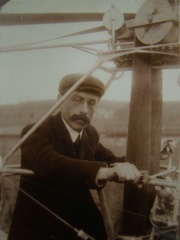
10. Paul Cornu (1881 - 1944)
With an HPI of 63.99, Paul Cornu is the 10th most famous French Engineer. His biography has been translated into 25 different languages.
Paul Cornu (French pronunciation: [pɔl kɔʁny]; 15 June 1881 – 6 June 1944) was a French engineer.
People
Pantheon has 62 people classified as French engineers born between 1200 and 1978. Of these 62, 4 (6.45%) of them are still alive today. The most famous living French engineers include Gérard Larrousse, Louis Pouzin, and Jean-Luc Sandoz. The most famous deceased French engineers include Gustave Eiffel, Nicolas Léonard Sadi Carnot, and Sébastien Le Prestre de Vauban. As of April 2024, 1 new French engineers have been added to Pantheon including Jean-Luc Sandoz.
Living French Engineers
Go to all RankingsGérard Larrousse
1940 - Present
HPI: 60.34
Louis Pouzin
1931 - Present
HPI: 57.38
Jean-Luc Sandoz
1960 - Present
HPI: 50.98
Julien Simon-Chautemps
1978 - Present
HPI: 42.53
Deceased French Engineers
Go to all RankingsGustave Eiffel
1832 - 1923
HPI: 83.25
Nicolas Léonard Sadi Carnot
1796 - 1832
HPI: 77.68
Sébastien Le Prestre de Vauban
1633 - 1707
HPI: 73.84
André Citroën
1878 - 1935
HPI: 73.43
Villard de Honnecourt
1200 - 1250
HPI: 68.49
Marcel Dassault
1892 - 1986
HPI: 65.85
Marcel Renault
1872 - 1903
HPI: 65.35
Henri Farman
1874 - 1958
HPI: 65.26
Petrus Peregrinus de Maricourt
1240 - 1300
HPI: 64.37
Paul Cornu
1881 - 1944
HPI: 63.99
André Courrèges
1923 - 2016
HPI: 63.61
François Laurent d'Arlandes
1742 - 1809
HPI: 62.92
Newly Added French Engineers (2025)
Go to all RankingsOverlapping Lives
Which Engineers were alive at the same time? This visualization shows the lifespans of the 25 most globally memorable Engineers since 1700.

